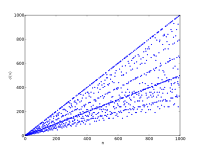Euler's totient function

Imagine you have a bunch of numbers, like 1, 2, 3, 4, 5, 6, and so on. Some of them are special because they are not like the other numbers. Those numbers have a special name: they are called prime numbers.
Now, let's say you pick a number from this bunch, like 8. You want to find out how many numbers in the bunch are not its friends, meaning they are not common multiples of 8. That's where the Euler's Totient Function comes in!
The function helps you to count how many of those numbers are not friends with the number you chose, by checking how many numbers in the bunch are relatively prime to it. In simpler terms, it counts how many numbers do not have any common factors (other than 1) with your chosen number.
For instance, let's say you pick the number 9. The list of numbers that are not its friends (not divisible by 9) are: 1, 2, 4, 5, 7, and 8. So, the Euler's Totient Function of 9 will be 6, which is the number of non-friends in the bunch.
The Euler's Totient Function also helps you to calculate with bigger numbers, like 21, 36, or even 100. By using this function, you can find out how many numbers are not friends with a particular number, which is helpful in some mathematical problems.
Overall, Euler's Totient Function is like a calculator that helps you find out how many numbers are not friends with your chosen number, by checking how many numbers in the bunch are relatively prime to it.
Now, let's say you pick a number from this bunch, like 8. You want to find out how many numbers in the bunch are not its friends, meaning they are not common multiples of 8. That's where the Euler's Totient Function comes in!
The function helps you to count how many of those numbers are not friends with the number you chose, by checking how many numbers in the bunch are relatively prime to it. In simpler terms, it counts how many numbers do not have any common factors (other than 1) with your chosen number.
For instance, let's say you pick the number 9. The list of numbers that are not its friends (not divisible by 9) are: 1, 2, 4, 5, 7, and 8. So, the Euler's Totient Function of 9 will be 6, which is the number of non-friends in the bunch.
The Euler's Totient Function also helps you to calculate with bigger numbers, like 21, 36, or even 100. By using this function, you can find out how many numbers are not friends with a particular number, which is helpful in some mathematical problems.
Overall, Euler's Totient Function is like a calculator that helps you find out how many numbers are not friends with your chosen number, by checking how many numbers in the bunch are relatively prime to it.
Related topics others have asked about:
